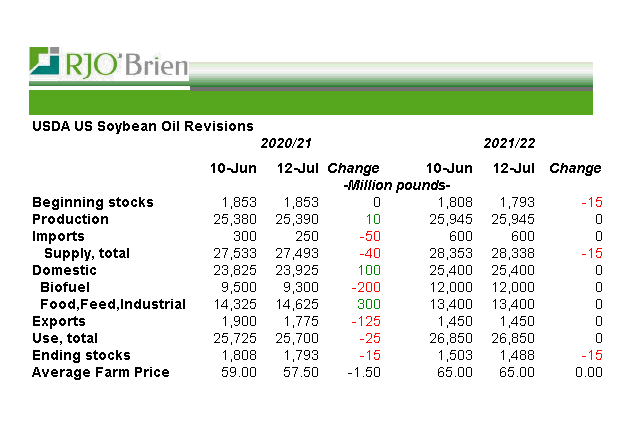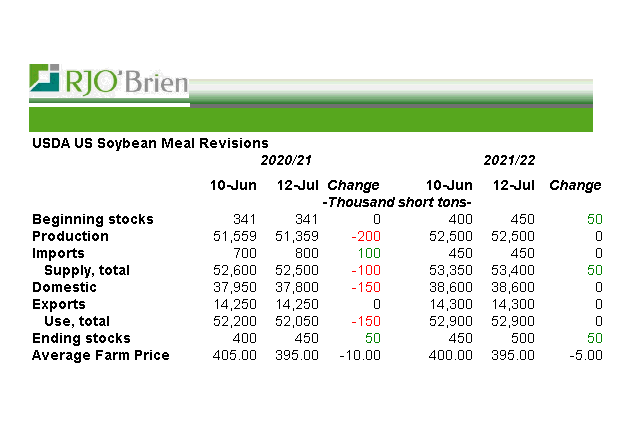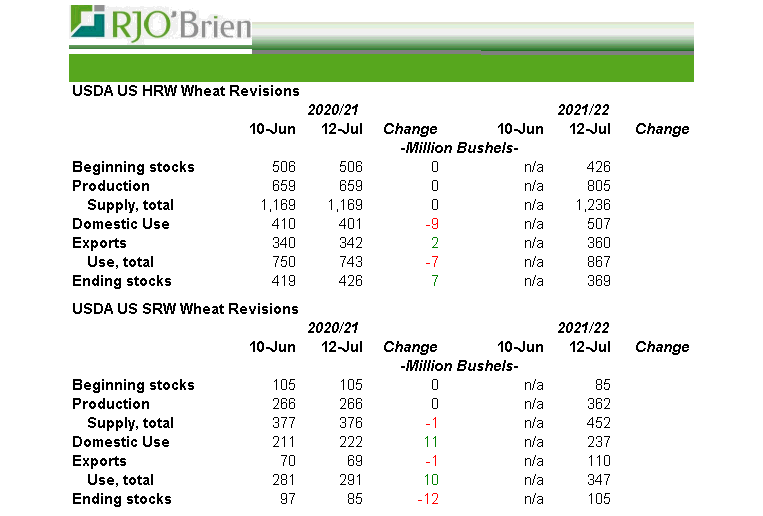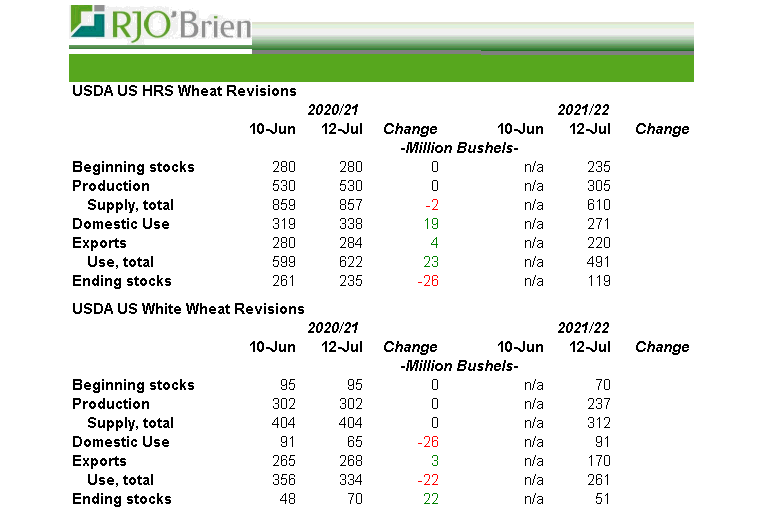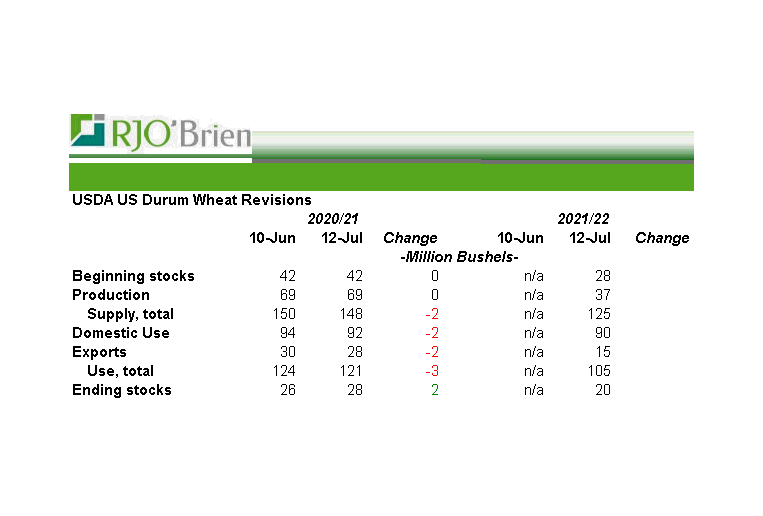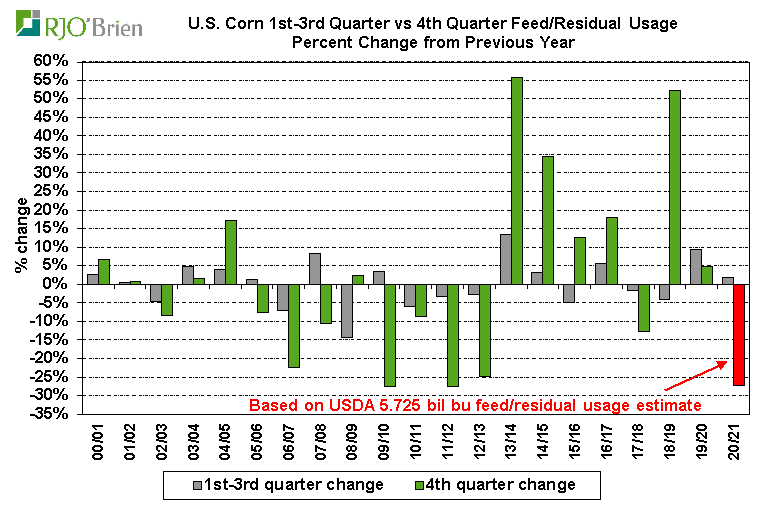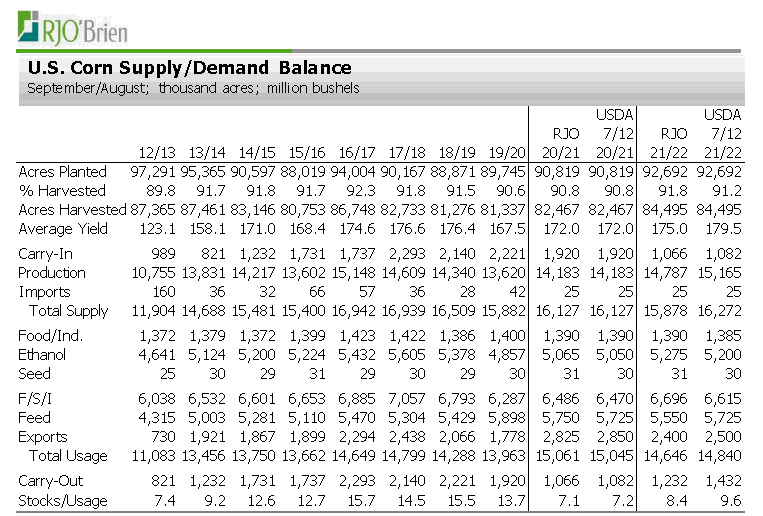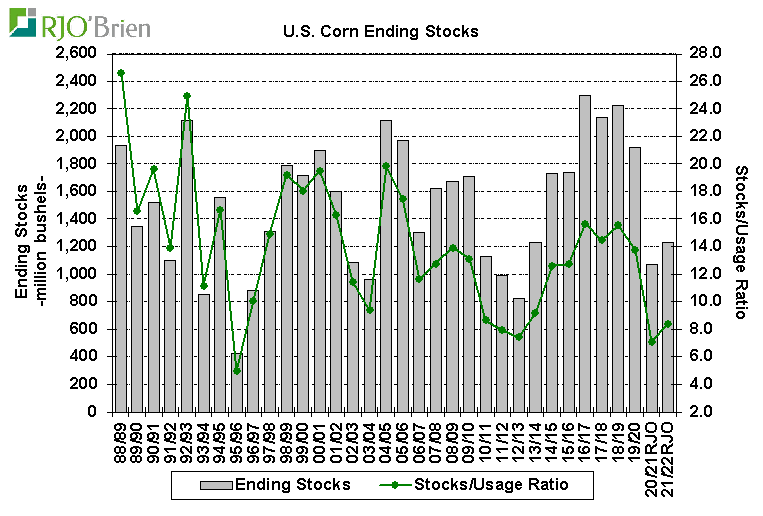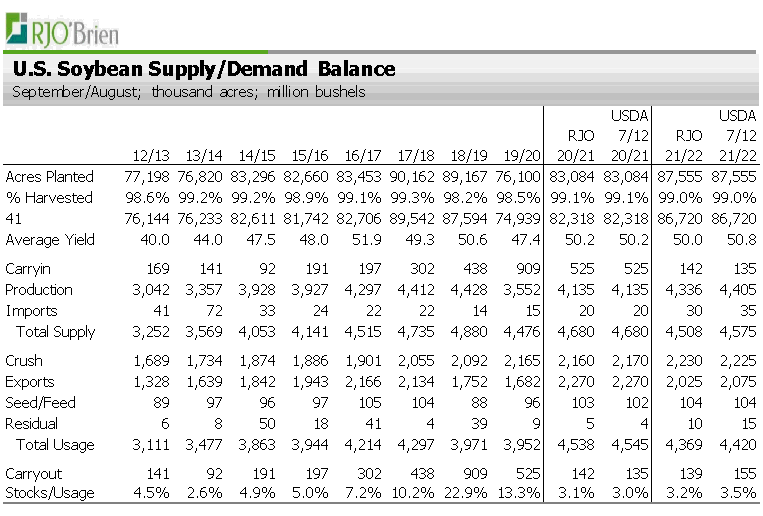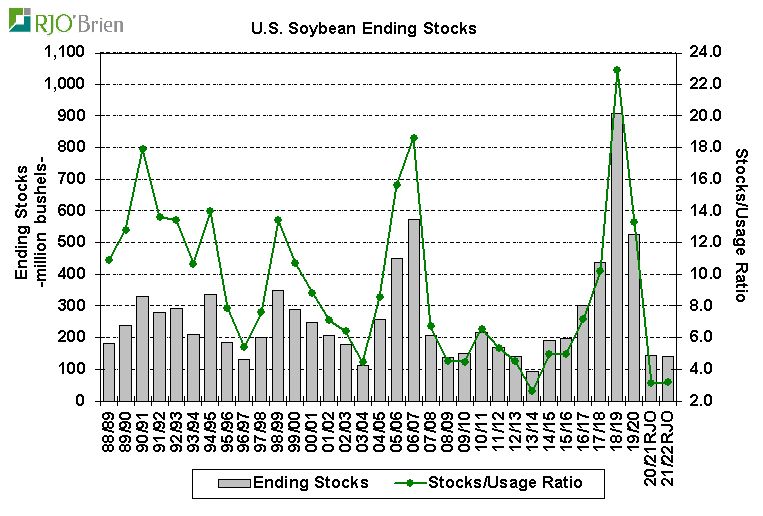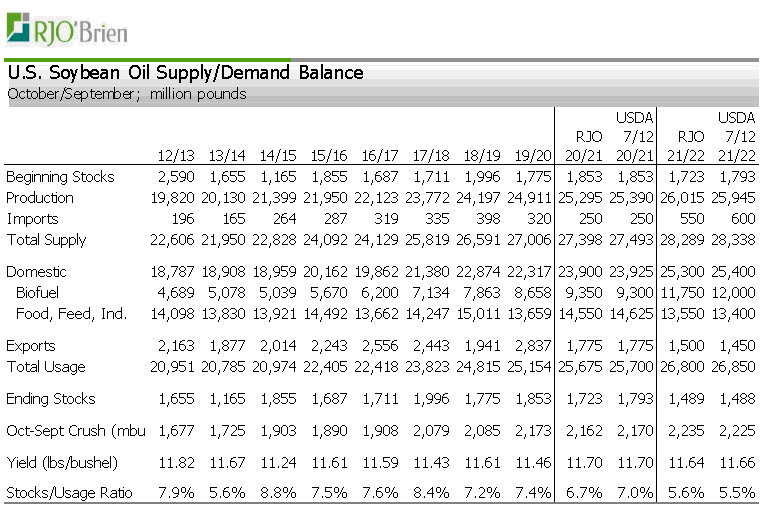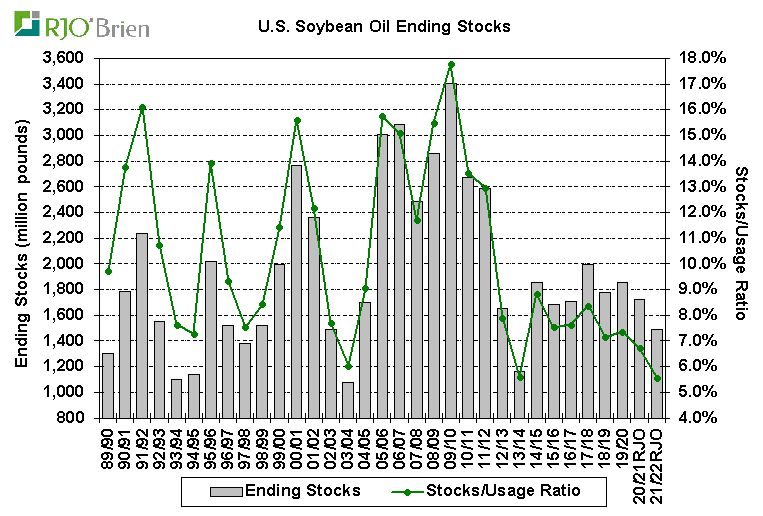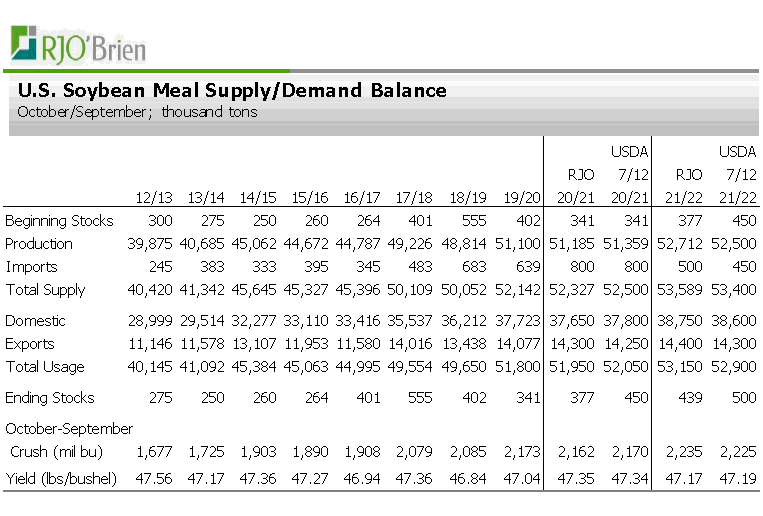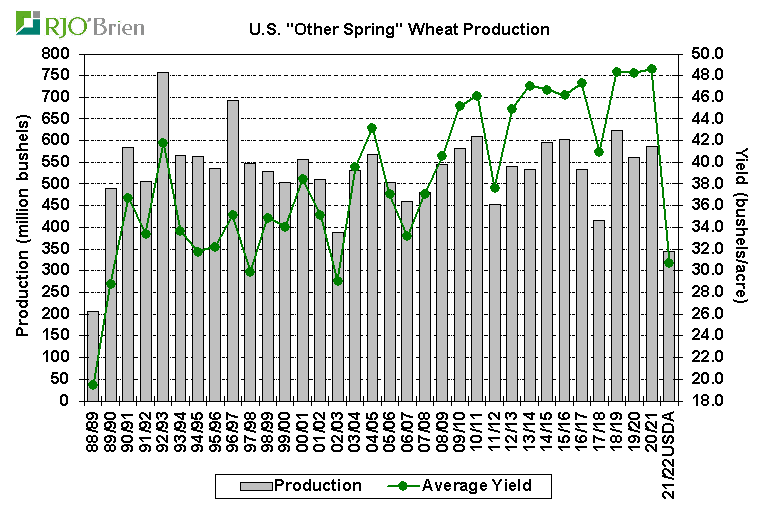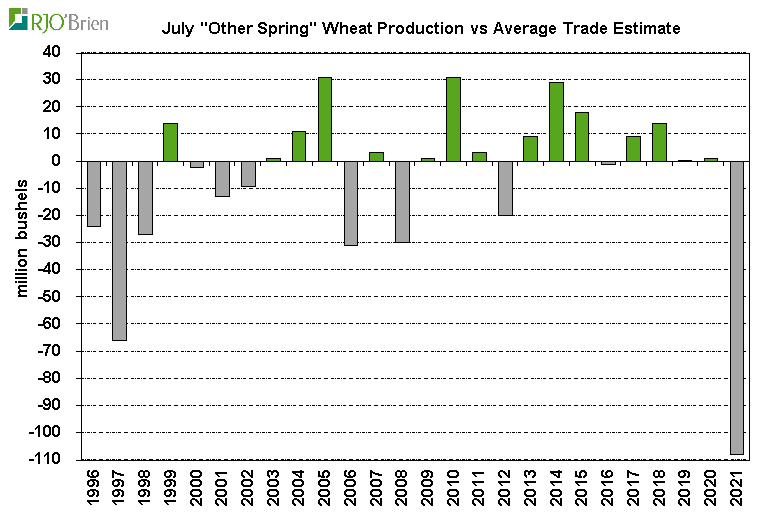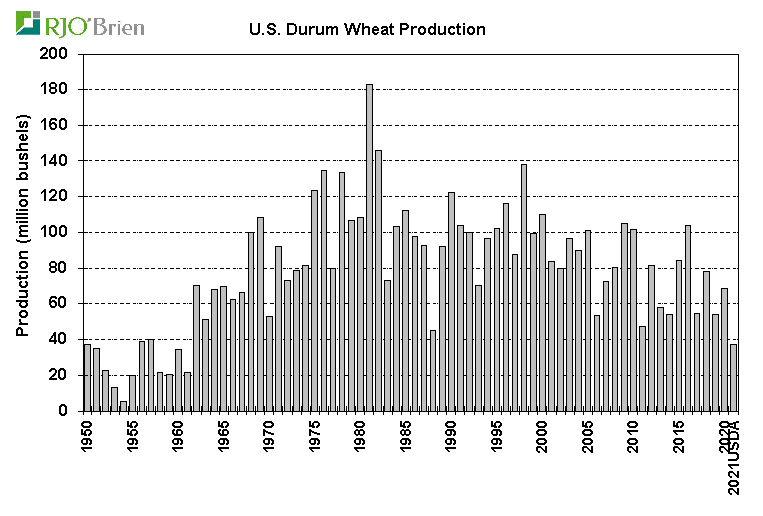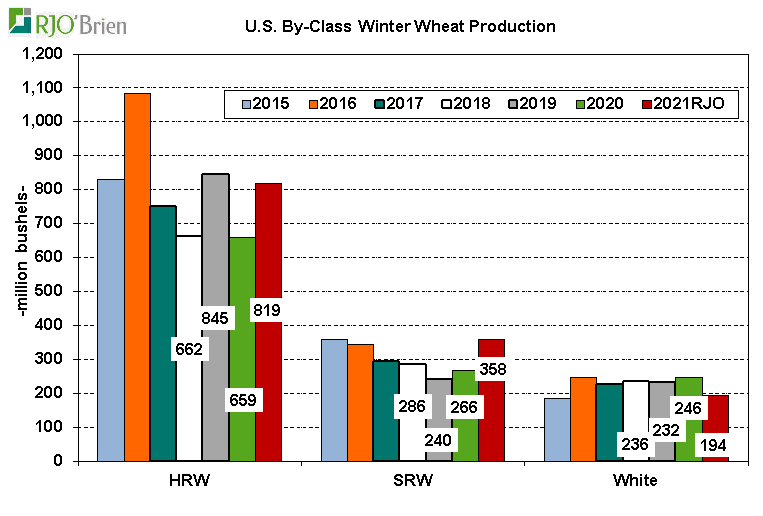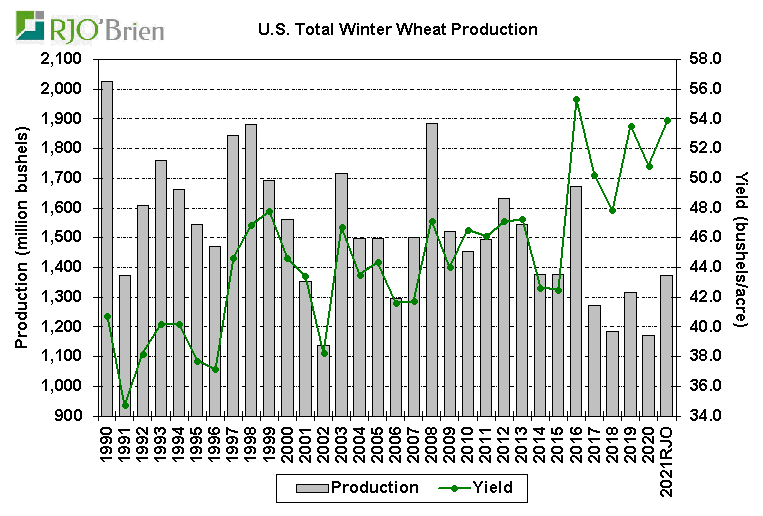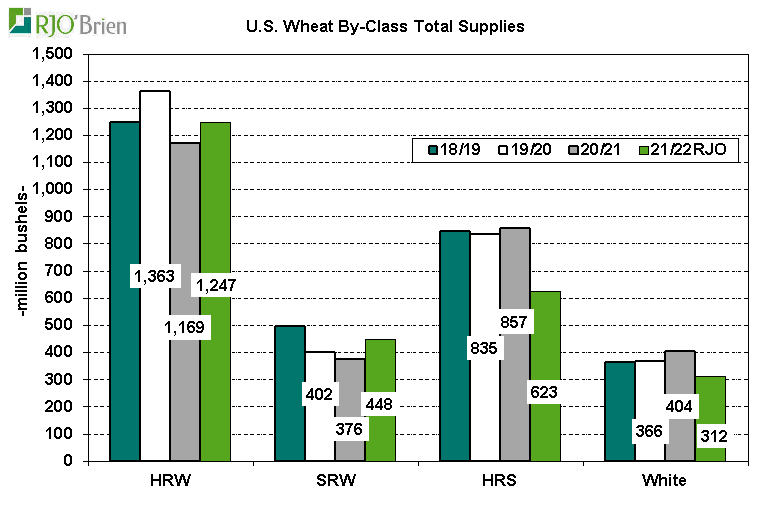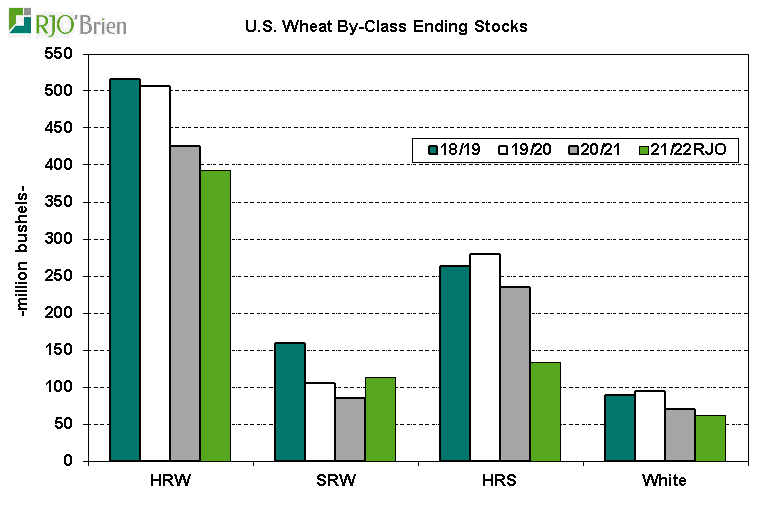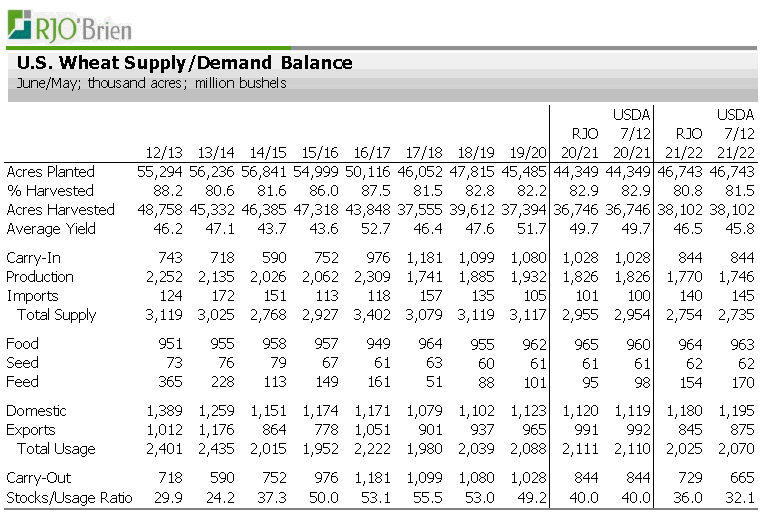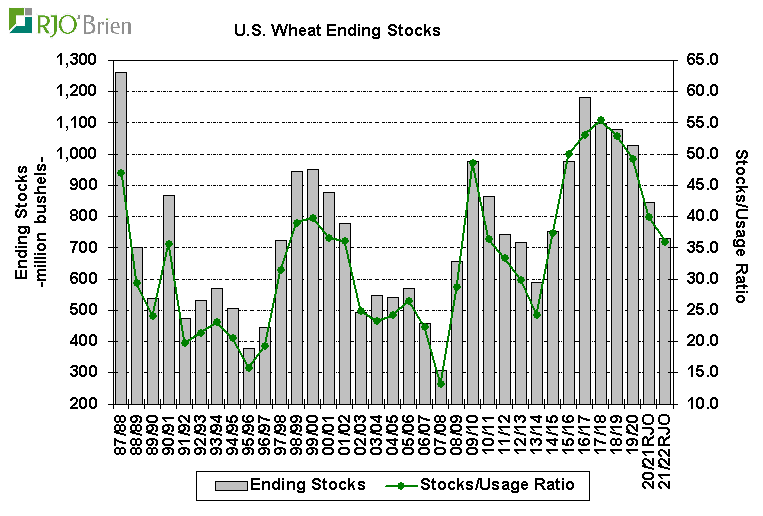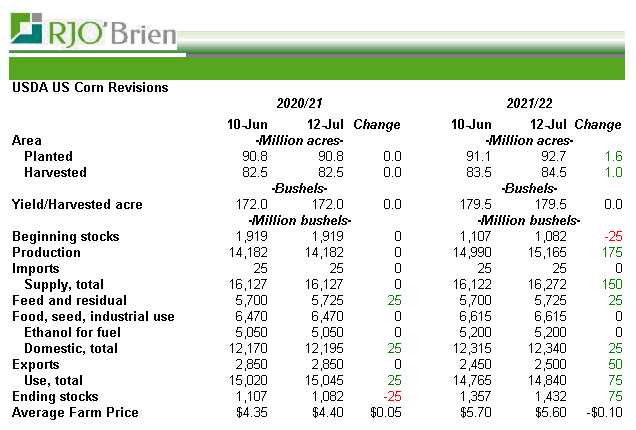Wheat stole the show in this month’s USDA report with the first official estimate of the U.S. spring wheat crop proving shockingly low, prompting a reassessment of by-class demand ideas for 2021/22. USDA made necessary, routine revisions to the old crop U.S. corn and soybean balance sheets this month while playing the waiting game on new crop developments prior to their first objective field survey-based estimates of the year in the August report.
A summary of key report numbers relative to market expectations is attached to this post as a PDF file.
Corn
Today’s USDA U.S. corn balance sheet revisions really didn’t provide much new to the market with minimal old crop changes being made, while USDA was allowed the luxury of higher new crop production, as a result of the Acreage report numbers, to at least raise demand for now, while bumping 2021/22 ending stocks a bit higher to slightly more comfortable levels. However, the ultimate look of the new crop balance sheet will be heavily influenced by size of the crop and, for now, questions certainly remain in that regard.
USDA was limited/conservative with their 2020/21 balance sheet revisions today, as expected, only slightly bumping feed/residual usage higher by 25 million bushels to 5.725 billion following the release of the quarterly Grain Stocks report on June 30. Based on the new estimate, 4th quarter (June-Aug) feed/residual usage needs to be down 27% from last year to 698 million bushels, which would be a historically significant level of rationing for the quarter, but comparable to past years’ tight balance sheet late-year cuts. As discussed in our pre-report commentary, we’re at 5.750 billion bushels for annual feed/residual usage and holding steady.
Not surprisingly, USDA left old crop exports and corn for ethanol usage unchanged this month, with both tracking close enough to current estimates to allow the leeway of waiting for another month. However, we’re increasingly of the opinion final corn for ethanol usage is likely to prove above the USDA’s 5.050 billion bushel estimate and exports a bit lower than their 2.850 billion bushel estimate.
With the 25 million bushel revision to feed being the only change, USDA lowered 2020/21 U.S. corn ending stocks by the same amount to 1.082 billion, with their stocks/usage ratio estimate now at 7.2%. Based on our slightly different demand ideas, our old crop ending stocks estimate sits at 1.066 billion bushels vs 1.920 billion last year, with a 7.1% stocks/usage ratio vs 13.7% last year.
Turning to new crop, while there apparently was some surprise to some in the market USDA raised 2021/22 U.S. corn production ideas, resulting in “higher than expected†ending stocks, today’s revisions were par for the course in how they’ve handled July WASDEs in the past, assuming the June 30 Acreage report numbers, while leaving the U.S. average yield unchanged until the August objective production estimate. The revisions resulted in USDA raising the corn crop by 175 million bushels to 15.165 billion, exactly as we discussed in our pre-report commentary. On that note, over the coming weeks, the focus on weekly crop condition updates is going to be extremely heavy as current conditions, in our opinion, do not justify/warrant the USDA’s 179.5 bushel/acre estimate, with the relationship between crop conditions and yields indicating something closer to a 175 bu/acre yield if final conditions prove near current conditions. Clearly much improved rains have been seen across the eastern 2/3 of the corn belt, which should improve conditions/yield prospects moving forward, but the offset of likely continued deteriorating yields in the west also needs to be watched moving forward. For now, we continue to assume a yield reflective of current crop conditions in our balance sheet, adjusting as needed to changing yield prospects in the weeks/months ahead.
On the demand side, USDA took the opportunity of 150 million bushels of larger total supplies to bump 2021/22 exports up by 50 million bushels to 2.500 billion and feed/residual usage by 25 million to 5.725 billion. With USDA cutting Brazilian exports by 5.0 MMT this month to 28.0 MMT, now reflecting a 7.2 MMT (283 mil bu) reduction from last year, many will continue to question the USDA’s estimated 350 million bushel decline in U.S. corn exports in the coming year. However, the massive unknown of China’s potential corn imports for another year looms large, while Ukrainian exports are estimated to be up 7.5 MMT (295 mil bu) this year vs last.
Both our feed/residual usage and export estimates are lower than USDA, but due to the balance sheet constraints of a 175 bu/acre yield as further demand rationing would be required with a sub-trend yield performance. Feed/residual usage, in particular, may simply become a factor of the ultimate crop size once that is known as the livestock industries adjust in response. The expected large Chinese corn crop this year may result in lower import needs, but for now, USDA is not reflecting that, holding 21/22 imports at 26.0 MMT, unchanged from this year.
With total new crop demand raised 75 million bushels, only partially offsetting the 150 million bushel increase in total supplies, USDA raised 2021/22 U.S. corn ending stocks by 75 million bushels to 1.432 billion, pushing the stocks/usage ratio back up to 9.6%, clearly a much more comfortable situation than old crop stocks under 1.1 billion, but highly unknown given the crop uncertainties still in play. Again, this was opposite of the apparent market expectation for USDA to lower new crop ending stocks by around 50 million bushels to 1.304 billion bushels based on the average trade estimate, but we question than mentality given the USDA’s handling of the July WASDE reports in the past. We continue to see new crop ending stocks lower than USDA, as we’re at 1.232 billion bushels given our lower yield assumption for now, forcing lower usage, as well.
In other global revisions, USDA partially countered the 5.5 MMT cut in the Brazilian crop to 93.0 MMT from 98.5 MMT previously (102.0 MMT last year) with a 1.5 MMT increase in Argentina’s crop to 48.5 MMT (51.0 MMT last year), prompting a 1.5 MMT increase in exports to 35.5 MMT (36.3 MMT last year), while China’s balance sheet was unchanged. In all, USDA raised new crop global corn stocks by 1.8 MMT from last month to 291.2 MMT vs the average trade estimate of 286.9 MMT.
Soybeans
USDA made only minimal revisions to the 2020/21 U.S. soybean balance sheet, as we expected and discussed in our pre-report commentary, tweaking exports and crush lower, while also adjusting imports lower as a result of the slow place so far. USDA lowered old crop exports by 10 million bushels to 2.270 billion and crush by 5 million bushels to 2.170 billion. A bit larger of a reduction in crush appeared immediately justifiable to us, while the revision to exports could have been held off on for now, but we can’t disagree with it, even though it was minimal. We continue to feel old crop soybean crush is likely to prove another 10 million bushels below the USDA’s new estimate, while they are now in line with our export ideas. USDA also lowered 2020/21 imports by 15 million bushels to 20 million, a necessary move given the limited degree of imports so far, offsetting the lower demand estimates and leaving old crop ending stocks unchanged at 135 million bushels. At this point, we don’t have much to argue with regarding the USDA’s estimates.
Turning to new crop, USDA made absolutely no revisions whatsoever, unsurprisingly to us as the June 30 Acreage report figures were right in line with previous balance sheet assumptions and they tend not to revise yield ideas in the July report. Accordingly, USDA’s unchanged 155 million bushel 2021/22 U.S. soybean ending stocks estimate was above the average trade estimate of 140 million as there appeared to be a bit of a bias USDA would tweak the crop estimate lower. All new crop demand estimates were untouched this month with no need for revision at this time. USDA ticked their estimate of the 2021/22 U.S. soybean average farm price down 15 cents/bushel from last month to $13.70 and compares to $11.05 (down 20 cents from last month) for 2020/21.
Our new crop balance sheet features modestly lower production as current crop conditions indicate the potential for a sub-trend yield and will obviously be watched very closely and adjusted, as needed, in the months ahead. With our 2021/22 total supplies ideas currently 67 million bushels below USDA, we’re forced to pull back on export ideas to 2.025 billion bushels vs USDA’s 2.075 billion in order to maintain new crop ending stocks near minimal levels, as we’re at 139 million bushels. The story remains the same for soybeans with yields being absolutely critical to the look and feel of the 2021/22 balance sheet given the old crop tightness.
In world estimates, USDA lowered Argentine soybean exports to only 3.7 MMT from 6.4 MMT last month and 10.0 MMT last year in what would be the lowest exports in 12 years, while crush was bumped up to 43.0 (local marketing year basis) from 42.3 MMT previously vs 37.9 MMT last year and would be the highest in five years. USDA lowered Brazilian soybean exports by 1 MMT to 86.5 MMT (local marketing year basis), but still up solidly from 81.6 MMT last year and record high, with crush left unchanged at 46.8 MMT (46.0 MMT last year). USDA lowered old crop Chinese soybean imports by 2.0 MMT to 98.0 MMT and new crop imports by 1 MMT to 102 MMT.
For the products, USDA made widespread revisions to the old crop balance sheets, but left new crop nearly unchanged. In soybean oil, USDA raised 2020/21 total domestic usage by 100 million pounds, accomplished by offsetting a 300 million pound increase in food/industrial usage with a 200 million pound reduction in biodiesel. USDA also made another much-needed further cut in soybean oil exports by 125 million pounds to 1.775 billion (2.837 billion last year), finally appearing appropriate given the minimal pace of export sales of late. Over the last 9 weeks, SBO sales have averaged a miniscule 1.0k tonnes/week. USDA also lowered imports by 50 million pounds to 250 million. In all, USDA lowered 2020/21 soybean oil stocks by 15 million pounds to 1.793 billion. No changes were made to 2021/22 other than the carry through impact of the lower old crop stocks.
Old crop soybean meal revisions included 200k ton production reduction (51.359 million/51.100 million last year), 100k ton increase in imports to 800k and a 150k ton decline in domestic usage (37.8 million tons/38.0 million last year), resulting in stocks ticking up by 50k tons to 450k. As in SBO, no other new crop revisions were made other than carrying through the change in old crop stocks.
Wheat
While the corn and soybean markets saw a mostly uneventful report day from USDA, the same cannot be said for wheat for a change as USDA was not shy with their first official look at the U.S. spring wheat crop, reflecting a truly disastrous situation and resulting in the largest “bullish surprise†on record for the July Crop Production report. On the other hand, the winter wheat crop keeps getting bigger, with the USDA’s 55 million bushel upward revision notably outpacing the average trade estimate reflecting average ideas for a 22 million bushel increase from last month.
USDA estimated the “other spring†wheat crop at a 33-year low of 345 million bushels, a massive 108 million bushels below the average trade estimate and down 241 million bushels from last year’s 586 million. The average yield was estimated at 30.7 bushels/acre vs 48.6 last year and the lowest since 2002’s 29.1 bushels/acre. With crop conditions the 2nd lowest on record, obviously a significantly lower crop was expected, but today’s estimate revealed the devastation the continued hot/dry conditions have caused this growing season. The hard red spring wheat crop, specifically, was estimated at 305 million bushels vs 530 million last year, the most-recent 5-year average of 503 million bushels and the lowest since 1988. Not to be outdone, USDA estimated the durum wheat crop at only 37 million bushels, nearly half of last year’s 69 million, also sharply below the average trade estimate of 55 million bushels and reflecting a 60-year low.
On a state-level basis, the USDA put the North Dakota yield at a 24-year low of 28.0 bushels/acre vs 49.0 last year and the most-recent 5-year average of 46.8 bu/acre. 2nd largest producer Montana’s yield was estimated at 25.0 bu/acre, a 19-low and compares to 38.0 last year and 33.2 bu/acre 5-year average.
Conversely, as mentioned, USDA raised the winter wheat crop by another 55 million bushels to 1.364 billion, a 5-year high, with HRW now estimated at 805 million bushels, up 34 million from last month, SRW at 362 million, up 27 million, and white at 198 million, down 4 million. We feel the HRW crop could still tick a bit higher, white a bit lower, while being comfortable with the USDA’s SRW estimate.
Putting it all together, USDA estimated the 2021/22 U.S. all wheat crop at 1.746 billion bushels, down 152 million from last month’s assumption, down 80 million from last year’s 1.826 billion, well below the average trade estimate of 1.838 billion and the 2nd lowest of the last 19 years, only marginally above 2017/18’s 1.741 billion. Despite total supplies being cut 140 million bushels from last month, USDA held impressively steadfast on demand, only cutting 35 million bushels in total usage ideas, 25 million from exports and 10 million from feed/residual usage. USDA now sees U.S. wheat exports this year at 875 million bushels vs last year’s 992 million, while still estimating feed/residual usage at 170 million, up sharply from last year’s 98 million and an 8-year high. Obviously, the vast majority of feed usage will be from HRW and SRW supplies, which are both decently comfortable from an overall balance sheet perspective and can handle larger than usual feeding. As see in the following chart, relative to recent years, there is no concern for HRW and SRW supplies, while HRS and white supplies will be at multi-year lows.
The USDA’s first by-class balance sheets of the year issued today reflected the notable deviations in supply availability with sharply lower exports expected for HRS and white wheat from last year, and higher domestic usage for HRW and SRW relative to last year. Details of the USDA’s by-class balance sheets can be found at the end of this post, but highlights include the notably divergent export expectations with HRS exports estimated at 220 million bushels vs 284 million last year and white wheat at 170 million vs 268 million last year, while HRW exports are estimated at 360 million vs 342 million last year and SRW at 110 million vs 69 million last year. USDA sees HRW domestic usage at 507 million bushels vs 401 million last year and SRW at 237 million vs 222 million last year, while HRS domestic usage declines to 271 million from 338 million last year. With the solid usage, HRW ending stocks are still expected to decline from last year, with HRS stocks down solidly given the crop issues, while SRW stocks remain near recent-year levels.
Interestingly, when all was said and done, the USDA’s 105 million bushel cut in 2021/22 U.S. wheat ending stocks from last month to 665 million bushels, in what would be an 8-year low and was notably below average market expectations of 719 million bushels, still saw USDA only raise their average farm price ideas by 10 cents/bushel from last month to $6.60 and compares to $5.05 last year. We feel the USDA’s 875 million bushel export projection may prove optimistic, as we’re at 845 million, with our and USDA’s estimates reflecting 6-year lows. Clearly the U.S. wheat balance sheet is tightening up considerably given the massive spring wheat crop problem this year and should continue to prove nicely-supportive for the wheat market. On the other hand, it’s likely going to be a rather difficult demand year for U.S. wheat with global values continuing to run at steep discounts to the U.S., leaving our supplies the choice of last resort. USDA again raised combined competing exporters’ wheat exports this month by 1.5 MMT to 152.0 MMT, reflecting a 5 MMT increase from last year’s 147 MMT. Markets typically don’t get too excited about demand that can’t be monitored on a regular basis so without a solid export program, wheat may have difficulty sustaining true concerted upward momentum beyond the likely/expected periods of low volume, high volatility price spikes which can be seen during sharply-reduced crop years.
USDA Monthly Supply/Demand Balance Sheet Revisions

